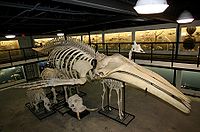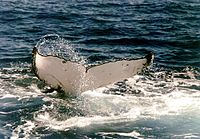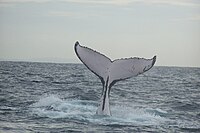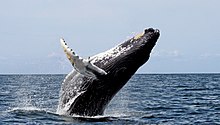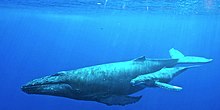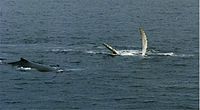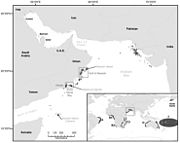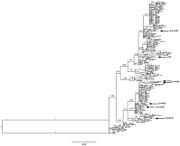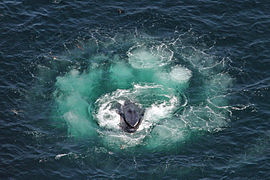| Humpback whale | |
|---|---|

| |

| |
| Size compared to an average human | |
| Scientific classification | |
| Kingdom: | Animalia |
| Phylum: | Chordata |
| Class: | Mammalia |
| Order: | Artiodactyla |
| Infraorder: | Cetacea |
| Family: | Balaenopteridae |
| Genus: | Megaptera Gray, 1846 |
| Species: |
M. novaeangliae
|
| Binomial name | |
| Megaptera novaeangliae
Borowski, 1781
| |
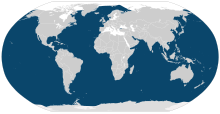
| |
| Humpback whale range | |
| Synonyms | |
| |
The humpback whale (Megaptera novaeangliae) is a species of baleen whale. It is one of the larger rorqual species, with adults ranging in length from 12–16 m (39–52 ft) and weighing around 25–30 metric tons (28–33 short tons). The humpback has a distinctive body shape, with long pectoral fins and a knobbly head. It is known for breaching and other distinctive surface behaviors, making it popular with whale watchers. Males produce a complex song lasting 10 to 20 minutes, which they repeat for hours at a time. All the males in a group will produce the same song, which is different each season. Its purpose is not clear, though it may help induce estrus in females.
Found in oceans and seas around the world, humpback whales typically migrate up to 25,000 km (16,000 mi) each year. They feed in polar waters, and migrate to tropical or subtropical waters to breed and give birth, fasting and living off their fat reserves. Their diet consists mostly of krill and small fish. Humpbacks have a diverse repertoire of feeding methods, including the bubble net technique.
Like other large whales, the humpback was a target for the whaling industry. The species was once hunted to the brink of extinction; its population fell by an estimated 90% before a 1966 moratorium. While stocks have partially recovered to some 80,000 animals worldwide, entanglement in fishing gear, collisions with ships and noise pollution continue to affect the species.
Taxonomy
Young whale with blowholes clearly visible
Humpback whales are rorquals, members of the Balaenopteridae family that includes the blue, fin, Bryde's, sei and minke whales. The rorquals are believed to have diverged from the other families of the suborder Mysticeti as long ago as the middle Miocene era. However, it is not known when the members of these families diverged from each other.
Though clearly related to the giant whales of the genus Balaenoptera, the humpback is the sole member of its genus. Recent DNA sequencing has indicated the humpback is actually more closely related to certain rorquals, particularly the fin whale (B. physalus) and possibly the gray (Eschrichtius robustus), than it is to others such as the minke.
The humpback was first identified as baleine de la Nouvelle Angleterre by Mathurin Jacques Brisson in his Regnum Animale of 1756. In 1781, Georg Heinrich Borowski described the species, converting Brisson's name to its Latin equivalent, Balaena novaeangliae. In 1804, Lacépède shifted the humpback from the family Balaenidae, renaming it B. jubartes. In 1846, John Edward Gray created the genus Megaptera, classifying the humpback as Megaptera longipinna, but in 1932, Remington Kellogg reverted the species names to use Borowski's novaeangliae. The common name is derived from the curving of their backs when diving. The generic name Megaptera from the Ancient Greek mega- μεγα ("giant") and ptera/ πτερα ("wing"),
refers to their large front flippers. The specific name means "New
Englander" and was probably given by Brisson due to regular sightings of
humpbacks off the coast of New England.
Genetic research in mid-2014 by the British Antarctic Survey
confirmed that the separate populations in the North Atlantic, North
Pacific and Southern Oceans are more distinct than previously thought.
Some biologists believe that these should be regarded as separate
subspecies and that they are evolving independently.
Anatomy
Humpbacks can easily be identified by their stocky body, obvious hump, black dorsal coloring and elongated pectoral fins. The head and lower jaw are covered with knobs called tubercles, which are hair follicles
and are characteristic of the species. The fluked tail, which typically
rises above the surface when diving, has wavy trailing edges.
Humpbacks have 270 to 400 darkly colored baleen plates on each side of their mouths. The plates measure from 18 in (46 cm) in the front to about 3 ft (0.91 m) in the back, behind the hinge.
Ventral grooves run from the lower jaw to the umbilicus,
about halfway along the underside of the body. These grooves are less
numerous (usually 14–22) than in other rorquals, but are fairly wide.
The female has a hemispherical lobe about 15 cm (5.9 in) in
diameter in her genital region. This visually distinguishes males and
females. The male's penis usually remains hidden in the genital slit.
Size
Fully grown
males average 13–14 m (43–46 ft). Females are slightly larger at 15–16 m
(49–52 ft); one large recorded specimen was 19 m (62 ft) long and had
pectoral fins measuring 6 m (20 ft) each.
The largest humpback on record, according to whaling records, was a
female killed in the Caribbean; she was 27 m (89 ft) long with a weight
of 90 metric tons (99 short tons), although the reliability of these
extremely atypical data is impossible to confirm.
The largest measured by the scientists of the Discovery Committee were a
female and a male at 14.9 and 14.75 m (48.9 and 48.4 ft) respectively,
although this was out of a sample size of only 63 whales.
Body mass typically is in the range of 25–30 metric tons (28–33 short
tons), with large specimens weighing over 40 metric tons (44 short
tons).
Fins
Several hypotheses attempt to explain the humpback's pectoral fins, which are proportionally the longest fins of any cetacean.
The higher maneuverability afforded by long fins and the usefulness of
the increased surface area for temperature control when migrating
between warm and cold climates may have supported this adaptation. These
very long heavy pectoral fins with a row of knuckle-like knobs along their anterior edges are effective weapons in confrontations with killer whales. Humpbacks frequently defend other animals against attack by predators; for example, they were observed interfering to defend a grey whale calf that had just been killed by killer whales. The large sharp-cornered barnacle Coronula diadema often attaches there, adding a natural equivalent of knuckledusters.
Identifying individuals
The
varying patterns on the tail flukes distinguish individual animals.
Identification is done by comparing the amount of white vs black and
scars on the fluke. The humpback whales are then given a catalogue
number. A study using data from 1973 to 1998 on whales in the North
Atlantic gave researchers detailed information on gestation times,
growth rates and calving periods, as well as allowing more accurate
population predictions by simulating the mark-release-recapture technique. A photographic catalogue of all known North Atlantic whales was developed over this period and is maintained by College of the Atlantic. Similar photographic identification projects operate around the world.
- Mother and calf in Boston Harbor
- Humpback whale skeleton of "Snow" on display at Glacier Bay National Park and Preserve
Behavior
The lifespan of rorquals ranges from 45 to 100 years.
Interactions
Humpbacks frequently breach, throwing two-thirds or more of their bodies out of the water and splashing down on their backs
Courtship and reproduction
Courtship rituals take place during the winter months, following migration toward the equator from summer feeding grounds closer to the poles.
Competition is usually fierce. Unrelated males, dubbed escorts,
frequently trail females, as well as cow-calf pairs. Males gather into
competitive groups around a female and fight for the right to mate with
her. Group size ebbs and flows as unsuccessful males retreat and others arrive. Behaviors include breaching, spyhopping, lob-tailing, tail-slapping, pectoral fin-slapping, peduncle throws, charging and parrying.
Whale song is thought to have an important role in inducing estrus in females and in mate selection; however, it may also be used between males to establish dominance. Humpback whales are polyandrous, with a female having multiple male partners over the course of her lifespan.
Female humpback whale with her calf
Females typically breed every two or three years. The gestation
period is 11.5 months. The peak months for birth are January and
February in the Northern Hemisphere, July and August in the Southern
Hemisphere. Females wait for one to two years before breeding again.
Recent research on mitochondrial DNA reveals that groups living in proximity to each other may represent distinct breeding pools. Humpback whale births have been rarely observed. One birth witnessed off Madagascar occurred within four minutes. Humpback whales have been known to hybridize with other rorquals; there is a well-documented report of a humpback-blue whale hybrid in the South Pacific.
Interspecies interactions
Humpbacks are a friendly species that interact with other cetaceans such as bottlenose dolphins. Right whales interact with humpbacks. These behaviors have been recorded in all oceans. Records of humpback and southern right whales demonstrating what were interpreted to be mating behaviors have been documented off the Mozambique and Brazilian coasts. Humpback whales appear in mixed groups with other species, such as the blue, fin, minke, gray and sperm whales. Interaction with gray, fin,
and right whales have been observed. Teams of researchers observed a
male humpback whale singing an unknown type of song and approaching a
fin whale at Rarotonga in 2014. One individual was observed playing with a bottlenose dolphin in Hawaiian waters. Incidents of humpback whales protecting other animals such as seals and other whales from killer whales
have been documented and filmed. Studies of such incidents indicate
that the phenomenon is species-wide and global, with incidents being
recorded at various locations across the world.
In September 2017 in Rarotonga, the Cook Islands, snorkeler and whale
biologist Nan Hauser reported that two adult humpback whales had
protected her from a 4.5 m (15 ft) tiger shark, with one whale pushing her away from the shark while the other used its tail to block the shark's advances.
Song
Spectrogram
of humpback whale vocalizations: detail is shown for the first 24
seconds of the 37-second recording "Singing Humpbacks". In this
recording, the ethereal whale "songs" are heard before and after a set
of communicative "clicks" in the middle.
Both male and female humpback whales vocalize, but only males produce
the long, loud, complex "song" for which the species is famous. Each
song consists of several sounds in a low register, varying in amplitude and frequency and typically lasting from 10 to 20 minutes. Individuals may sing continuously for more than 24 hours. Cetaceans
have no vocal cords, instead, they produce sound via a larynx-like
structure found in the throat, the mechanism of which has not been
clearly identified. Whales do not have to exhale to produce sound.
Whales within a large area sing a single song. All North Atlantic
humpbacks sing the same song, while those of the North Pacific sing a
different song. Each population's song changes slowly over a period of
years without repeating.
Scientists are unsure of the purpose of whale songs. Only males
sing, suggesting one purpose is to attract females or to induce estrus
in the females.
However, many of the whales observed to approach a singer are other
males, often resulting in conflict. Singing may, therefore, be a
challenge to other males. Some scientists have hypothesized the song may serve an echolocative function. During the feeding season, humpbacks make unrelated vocalizations for herding fish into their bubble nets.
Humpback whales make other sounds to communicate, such as grunts, groans, snorts and barks.
Breathing
Whales are air-breathing mammals who must surface to get the air they need. The stubby dorsal fin is visible soon after the blow
(exhalation) when the whale surfaces, but disappears by the time the
flukes emerge. Humpbacks have a 3 m (9.8 ft), heart-shaped bushy blow
through the blowholes. They do not generally sleep at the surface, but
they must continue to breathe. Possibly only half of their brain sleeps
at one time, with one half managing the surface-blow-dive process
without awakening the other half.
Migration
Migratory patterns and social interactions were explored in the 1960s, and by further studies in 1971.
Calambokidis et al. provided the "first quantitative assessment of the
migratory structure of humpback whales in the entire North Pacific
basin."
Range and habitat
Humpbacks inhabit all major oceans, in a wide band running from the Antarctic ice edge to 81°N
latitude. The four global populations are North Pacific, Atlantic,
Southern Ocean and Indian Ocean populations. These populations are
distinct. Although the species has cosmopolitan distribution and is
usually not considered to cross the equator line, seasonal observations
at Cape Verde suggest possible interactions among populations from both hemispheres. Aside from the Arabian Sea group, year-round presences have been confirmed among British and Norwegian waters. Parts of wintering grounds around the globe have been poorly studied or being undetected, such as around Pitcairn Islands, Northern Mariana Islands (e.g. Marpi and CK Reefs vicinity to Saipan), Volcano Islands, Pasaleng Bay, Trindade and Martin Vaz, Mauritius, and Aldabra.
Whales were once uncommon in the Mediterranean and the Baltic Seas,
but have increased their presence in both waters as global populations
have recovered. Recent increases within the Mediterranean basin,
including re-sightings, indicate that more whales may migrate into the
inland sea in the future, not only for wintering but also for feeding. Humpbacks are also showing signs of re-expanding into former ranges, such as Scotland, Skagerrak and Kattegat, as well as Scandinavian fjords such as Kvænangen, where they had not been observed for decades.
In the North Atlantic, feeding areas range from Scandinavia to New England. Breeding occurs in the Caribbean and Cape Verde.
In the South Atlantic and Indian Oceans, whales may breed off Brazil,
as well the coasts of central, southern and southeastern Africa
(including Madagascar). Whale visits into Gulf of Mexico have been infrequent, but occurred in the gulf historically. In the South Atlantic, about 10% of world population of the species possibly migrate to the Gulf of Guinea. Comparison of songs between those at Cape Lopez and Abrolhos Archipelago indicate that trans-Atlantic mixings between western and southeastern populations occur.
A large population spreads across the Hawaiian Islands every winter, ranging from the island of Hawaii in the south to Kure Atoll in the north. These animals feed in areas ranging from the coast of California to the Bering Sea. Humpbacks were first observed in Hawaiian waters in the mid-19th century and might have gained a dominance over North Pacific right whales, as the right whales were hunted to near-extinction.
A 2007 study identified seven individuals then wintering off the Pacific coast of Costa Rica
as having traveled from the Antarctic—around 8,300 km (5,200 mi).
Identified by their unique tail patterns, these animals made the longest
documented mammalian migration.
In Australia, two main migratory populations were identified, off the
west and east coasts. These two populations are distinct, with only a
few females in each generation crossing between the two groups.
In Panama
and Costa Rica, humpback whales come from both the Southern Hemisphere
(July–October with over 2,000 whales) and the Northern Hemisphere
(December–March numbering about 300). South Pacific populations migrating off mainland New Zealand, Kermadec Islands, and Tasmania are increasing, but less rapidly than in Australian waters because of illegal whaling by the Soviet Union in the 1970s.
Some recolonizing habitats are confirmed, especially in the North and South Atlantic (e.g. English and Irish coasts, English Channel) to coasts in the north such as the North Sea and Wadden Sea, where the first confirmed sighting since 1755 was made in 2003, South Pacific (e.g. New Zealand coasts and Niue), pelagic islands of Chile such as Isla Salas y Gómez and Easter Island, where possibilities of undocumented wintering grounds have been considered, southern fiords of Chile and Peru (e.g. Gulf of Penas, Strait of Magellan, Beagle Channel) and in Asia, such as in the Philippines such as the Babuyan Islands, Cagayan (the first modern mortality of the species in the nation was in 2007), Calayan and Pasaleng Bay, the Ryukyu Islands, the Volcano Islands in Japan and the Northern Mariana Islands recently again became stable/growing wintering grounds while the Marshall Islands, Vietnamese, Taiwanese and Chinese coasts show slow or no obvious recovery. In 2020, A whale has been spotted wandering at Saint Lawrence River in Montreal.
In Asia
Whales again migrate off Japanese archipelagos and into the Sea of Japan. Connections between these stocks and whales seen in the Sea of Okhotsk, on Kamchatka coasts and around the Commander Islands have been studied.
Historical wintering distributions could have been much wider and more
southerly distributed, as whales were seen in areas along the Batanes, Sulu and Celebes Seas including off Palawan, Luzon, Malaysia and Mindanao, with higher densities around today's Cape Eluanbi and Kenting National Park. Unconfirmed sightings have been reported near Borneo in modern times. The first confirmation in modern Taiwan was of a pair off Hualien in 1994, followed by a successful escape from entanglement off Taitung in 1999, and continuous sightings around Orchid Island in 2000. Few/none regularly migrate into Kenting National Park. In addition, despite sightings reported almost annually off Green and Orchid Islands, relatively short stays in these waters indicate recoveries as winter foraging has not occurred. Sightings, including of a cow-calf pair, have occurred along the east coast of Taiwan. Around Hong Kong, two documented sightings were recorded in 2009 and in 2016. One of the first documented sightings within the Yellow Sea was of a group of 3 or 4 individuals, including a cow/calf pair in Changhai County in October, 2015.
Since November 2015, whales gather around Hachijō-jima,
far north from the known breeding areas in the Bonin Islands. All
breeding activities except for giving births had been confirmed as of
January, 2016. That makes Hachijo-jima the northernmost breeding ground
in the world, north of breeding grounds such as Amami Ōshima, Midway Island, and Bermuda.
Arabian Sea
A non-migratory population in the Arabian Sea remains there year-round.
More typical annual migrations cover up to 25,000 km (16,000 mi),
making it one of the most-traveled mammalian species. Genetic studies
and visual surveys indicate that the Arabian group is the most isolated
of all humpback groups and is the most endangered, numbering possibly
fewer than 100 animals. Within the Arabian Sea, Masirah Island and Gulf of Masirah, Halaniyat Islands and Kuria Muria Bay are hot spots for the species.
Whales were historically common in continental and marginal waters such as the Hallaniyat Islands, along Indian coasts, Persian Gulf and Gulf of Aden, and recent migrations into the gulf including by cow-calf pairs. It is unknown whether whales seen in the Red Sea originate in this population, however sightings increased since in 2006 even in the northern part of the sea such as in Gulf of Aqaba. Individuals may reach the Maldives, Sri Lanka, or further east.
Humpbacks have been considered rather vagrant into Persian Gulf,
however new studies indicate more regular presences can be expected.
Origins of whales occurring at Maldives are not clear either from
Arabian or south Pacific populations, and overlaps are possible.
Feeding and predators
Humpbacks feed primarily in summer and live off fat reserves during winter. They feed only rarely and opportunistically in their wintering waters. The humpback is an energetic hunter, taking krill and small schooling fish such as juvenile Atlantic and Pacific salmon, herring, capelin and American sand lance, as well as Atlantic mackerel, pollock, haddock and Atlantic menhaden in the North Atlantic.
They have been documented opportunistically feeding near fish
hatcheries in Southeast Alaska, feasting on salmon fry released from the
hatcheries. Krill and copepods are prey species in Australian and Antarctic waters. Humpbacks hunt by direct attack or by stunning prey by hitting the water with pectoral fins or flukes.
- A group of 15 whales bubble net fishing near Juneau, Alaska
- A whale off Australia on the spring migration, feeding on krill by turning on its side and propelling through the krill
Bubble net
The humpback has the most diverse hunting repertoire of all baleen whales.
Its most inventive technique is known as bubble net feeding; a group of
whales swims in a shrinking circle blowing bubbles below a school of
prey. The shrinking ring of bubbles encircles the school and confines it
in an ever-smaller cylinder. This ring can begin near 30 m (98 ft) in
diameter and involve the cooperation of a dozen animals. Using a crittercam
attached to a whale's back, researchers found that some whales blow the
bubbles, some dive deeper to drive fish toward the surface and others
herd prey into the net by vocalizing.
The whales then suddenly swim upward through the "net", mouths agape,
swallowing thousands of fish in one gulp. The water is then squeezed out
through baleen plates in the mouth to filter out the prey.
So-called lobtail feeding was observed in the North Atlantic.
This technique involves the whale slapping the surface of the ocean with
its tail between one and four times before creating the bubble net. Using network-based diffusion analysis,
the study authors argued that these whales learned the behavior from
other whales in the group over a period of 27 years in response to a
change in the primary form of prey.
Killer whale and shark predation
Visible scars indicate that killer whales
(orcas) can prey upon juvenile humpbacks, though until recently hunting
had never been witnessed and attacks were assumed to be superficial in
nature. However, a 2014 study off Western Australia
observed that when available in large numbers, young humpbacks can be
attacked and sometimes killed by orcas. Moreover, mothers and (possibly
related) adults escort neonates
to deter such predation. The suggestion is that when humpbacks suffered
near-extinction during the whaling era, orcas turned to other prey, but
are now resuming their former practice. There is also evidence that
humpback whales will defend against or attack killer whales who are
attacking either humpback calves or juveniles as well as members of
other species. The great white shark is another confirmed predator of the humpback whale. In 2020, Marine biologists Dines and Gennari et al.,
published a documented incident they had recorded in 2019 in the
journal "Marine and Freshwater Research" of a group of great white
sharks exhibiting pack-like behavior to successfully attack and kill a
live adult humpback whale. The sharks utilized the classic attack
strategy they utilized on pinnipeds such as seals and sea lions when
attacking the whale, even utilizing the bite-and-spit tactic they employ
on said prey items. The incident is the first known documentation of
great whites actively killing a large baleen whale and the first record
known of a live humpback whale falling victim to this species of shark.
Relation to humans
Whaling
Humpback whales were hunted as early as the 18th century. By the 19th
century, many nations (particularly the United States) were hunting the
animal heavily in the Atlantic Ocean and to a lesser extent in the Indian and Pacific Oceans. The late-19th-century introduction of the explosive harpoon allowed whalers to accelerate their take. This, along with hunting in the Antarctic Ocean
beginning in 1904, sharply reduced whale populations. During the 20th
century, over 200,000 humpbacks were taken, reducing the global
population by over 90%. North Atlantic populations dropped to as low as
700 individuals.
Ban
In 1946, the International Whaling Commission (IWC) was founded to oversee the industry. They imposed hunting regulations and created hunting seasons. To prevent extinction, IWC banned commercial humpback whaling in 1966. By then, the global population had been reduced to around 5,000. The ban has remained in force since 1966.
Prior to commercial whaling, populations could have reached 125,000. North Pacific kills alone are estimated at 28,000.
The Soviet Union deliberately under-recorded its catches; the Soviets
reported catching 2,820 between 1947 and 1972, but the true number was
over 48,000.
As of 2004, hunting was restricted to a few animals each year off the Caribbean island of Bequia in the nation of St. Vincent and the Grenadines.
The take is not believed to threaten the local population. Japan had
planned to kill 50 humpbacks in the 2007/08 season under its JARPA II research program. The announcement sparked global protests.
After a visit to Tokyo by the IWC chair asking the Japanese for their
co-operation in sorting out the differences between pro- and antiwhaling
nations on the commission, the Japanese whaling fleet agreed to take no
humpback whales during the two years it would take to reach a formal
agreement.
In 2010, the IWC authorized Greenland's native population to hunt a few humpback whales for the following three years.
In Japan, humpback, minkes, sperm and many other smaller Odontoceti, including critically endangered species such as North Pacific right, western gray and northern fin,
have been targets of illegal captures. The hunts use harpoons for
dolphin hunts or intentionally drive whales into nets, reporting them as
cases of entanglement. Humpback meat can be found in markets. In one
case, humpbacks of unknown quantities were illegally hunted in the Exclusive Economic Zones of anti-whaling nations such as off Mexico and South Africa.
Whale-watching
Humpback breaching near coast
Whale watching is the leisure activity of observing humpbacks in the
wild. Participants watch from shore or on touring boats. Humpbacks are
generally curious about nearby objects. Some individuals, referred to as
"friendlies", approach whale-watching boats closely, often staying
under or near the boat for many minutes. Because humpbacks are typically
easily approachable, curious, identifiable as individuals and display
many behaviors, they have become the mainstay of whale tourism around
the world. Hawaii has used the concept of "ecotourism"
to benefit from the species without killing them. This business brings
in revenue of $20 million per year for the state's economy.
|
|
North Atlantic | North Pacific | Southern Hemisphere |
|---|---|---|---|
| Summer | New York, New England, Grand Manan Island, Nova Scotia and Newfoundland, the northern St. Lawrence River, the Snaefellsnes peninsula in the west of Iceland. | Bahía Solano and Nuquí in Colombia, California, Alaska, Oregon, Washington, British Columbia, Isla Iguana in Panama, Ecuador. | Antarctica. |
| Winter | Samaná Province of the Dominican Republic, the Bay of Biscay France, Mona Passage off the coast of Puerto Rico | Hawaii, Baja California Sur, the Bahía de Banderas off Puerto Vallarta, Ogasawara, Okinawa | Sydney, Byron Bay north of Sydney, Hervey Bay north of Brisbane, North and East of Cape Town, New Zealand especially Kaikoura, the Tongan islands, Victor Harbor and outlying beaches, Saint Helena in the South Atlantic. |
Notable individuals
The Tay whale
Professor John Struthers about to dissect the Tay Whale, Dundee, photographed by George Washington Wilson in 1884
In December 1883, a male humpback swam up the Firth of Tay in Scotland, past what was then the whaling port of Dundee. Harpooned during a failed hunt, it was found dead off of Stonehaven
a week later. Its carcass was exhibited to the public by a local
entrepreneur, John Woods, both locally and then as a touring exhibition
that traveled to Edinburgh and London. The whale was dissected by Professor John Struthers, who wrote seven papers on its anatomy and an 1889 monograph on the humpback.
Migaloo
Possible Migaloo sighted off the Royal National Park
An albino
humpback whale that travels up and down the east coast of Australia
became famous in local media because of its rare, all-white appearance.
Migaloo is the only known Australian all-white specimen and is a true albino. First sighted in 1991, the whale was named for an indigenous Australian
word for "white fella". To prevent sightseers approaching dangerously
close, the Queensland government decreed a 500-m (1600-ft) exclusion
zone around him.
Humphrey
In 1985, Humphrey swam into San Francisco Bay and then up the Sacramento River towards Rio Vista. Five years later, Humphrey returned and became stuck on a mudflat in San Francisco Bay immediately north of Sierra Point below the view of onlookers from the upper floors of the Dakin Building. He was twice rescued by the Marine Mammal Center and other concerned groups in California. He was pulled off the mudflat with a large cargo net and the help of the US Coast Guard. Both times, he was successfully guided back to the Pacific Ocean using a "sound net" in which people in a flotilla of boats made unpleasant noises behind the whale by banging on steel pipes, a Japanese fishing technique known as oikami.
At the same time, the attractive sounds of humpback whales preparing to
feed were broadcast from a boat headed towards the open ocean. He was last sighted in the vicinity of the Farallon Islands in 1991.
Media
Analyses of whale songs in the 1960s led to worldwide media interest and convinced the public that whales were highly intelligent, aiding the antiwhaling advocates.
Status
Threats
A dead humpback washed up near Big Sur, California
While whaling no longer threatens the species, individuals are vulnerable to collisions with ships, entanglement in fishing gear and noise pollution.
Like other cetaceans, humpbacks can be injured by excessive noise. In
the 19th century, two humpback whales were found dead near sites of
repeated oceanic sub-bottom blasting, with traumatic injuries and
fractures in the ears.
Saxitoxin, a paralytic shellfish poisoning from contaminated mackerel, has been implicated in humpback whale deaths.
Whale researchers along the Atlantic Coast report that there have
been more stranded whales with signs of vessel strikes and fishing gear
entanglement in recent years than ever before. The NOAA
recorded 88 stranded humpback whales between January 2016 and February
2019. This is more than double the number of whales stranded between
2013 and 2016. Because of the increase in stranded whales NOAA
declared an unusual mortality event in April 2017. This declaration
still stands. Virginia Beach aquarium's stranding response coordinator,
Alexander Costidis says the conclusions are that the two causes of these
unusual mortality events are vessel interactions and entanglements.
Conservation
Humpback whale in Colombia's Uramba Bahía Málaga National Natural Park, a favorite place for whales to give birth to their young, making it a tourist destination
The worldwide population is at least 80,000, with 18,000–20,000 in the North Pacific, about 12,000 in the North Atlantic and over 50,000 in the Southern Hemisphere, down from a prewhaling population of 125,000.
The NOAA is committed to protecting and recovering the humpback whale. NOAA
enacted vessel speed restrictions which serve to protect the endangered
North Atlantic right whale and many other species of whales. They
respond to dead, injured, or entangled whales. They also educate whale
watchers, tourists, and vessel operators on responsible viewing of the
humpback whales. NOAA works to develop methods to reduce vessel strikes and reduce risk of entanglement in fishing gear. The NOAA's work will help reduce the number of humpback whale deaths.
Least concern
In August 2008, the IUCN changed humpbacks' status from Vulnerable to Least Concern, although two subpopulations remain endangered.
The United States is considering listing separate humpback populations,
so smaller groups, such as North Pacific humpbacks, which are estimated
to number 18,000–20,000 animals, might be delisted. This is made
difficult by humpbacks’ migrations, which can extend 5,157 miles
(8,299 km) from Antarctica to Costa Rica. In Costa Rica, the Ballena Marine National Park is designed for humpback protection.
Areas where population data is limited and the species may be at higher risk include the Arabian Sea, the western North Pacific Ocean, the west coast of Africa and parts of Oceania.
The species was listed as vulnerable in 1996 and endangered as recently as 1988. Most monitored stocks have rebounded since the end of commercial whaling.
In the North Atlantic stocks are believed to be approaching prehunting
levels. However, the species is considered endangered in some countries,
including the United States.
United States
A 2008 US Department of Commerce
analysis (SPLASH) noted that the many challenges to determining the
recovery status included the lack of accurate population estimates, the
unexpected complexity of population structures and their migration. The
report was based on data collected from 2004 to 2006. At the time, the
North Pacific population was some 18,302.
The estimate is consistent with a moderate rate of recovery for a
depleted population, although it was considered to be a "dramatic
increase in abundance" from other post-1960s estimates. By comparison,
Calambokidis et al. estimated 9,819, covering 1991–1993. This represents a 4% annual increase in population from 1993 to 2006. The sanctuary provided by US national parks, such as Glacier Bay National Park and Preserve and Cape Hatteras National Seashore, became major factors in population recovery.
Canada
Off the west coast of Canada, the Gwaii Haanas National Marine Conservation Area Reserve
covers 3,400 square kilometres (1,300 sq mi). It is "a primary feeding
habitat" of the North Pacific population. Their critical habitat
overlaps with tanker shipping routes between Canada and its eastern
trade partners.
In 2005 the North Pacific population was listed as threatened under
Canada's Species at Risk Act (SARA). On April 19, 2014 the Department of
the Environment recommended an amendment to SARA to downgrade their
status off the Pacific coast from "threatened" to "species of special
concern". According to Committee on the Status of Endangered Wildlife in Canada
(COSEWIC), the North Pacific humpback population increased at about 4%
annually from 1992 to 2008. Although socioeconomic costs and benefits
were considered in their decision to upgrade their status, according to
the University of British Columbia's Marine Mammal Research Consortium's
research director, the decision was based on biology, not politics.




